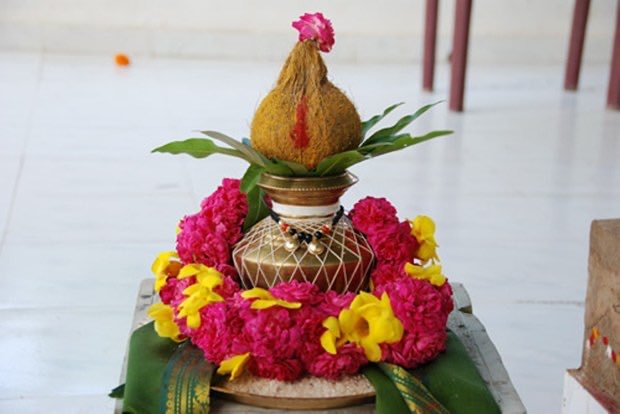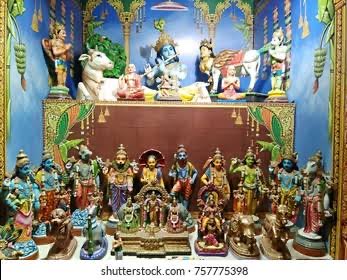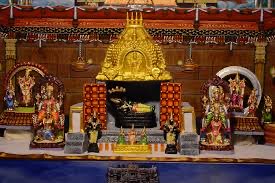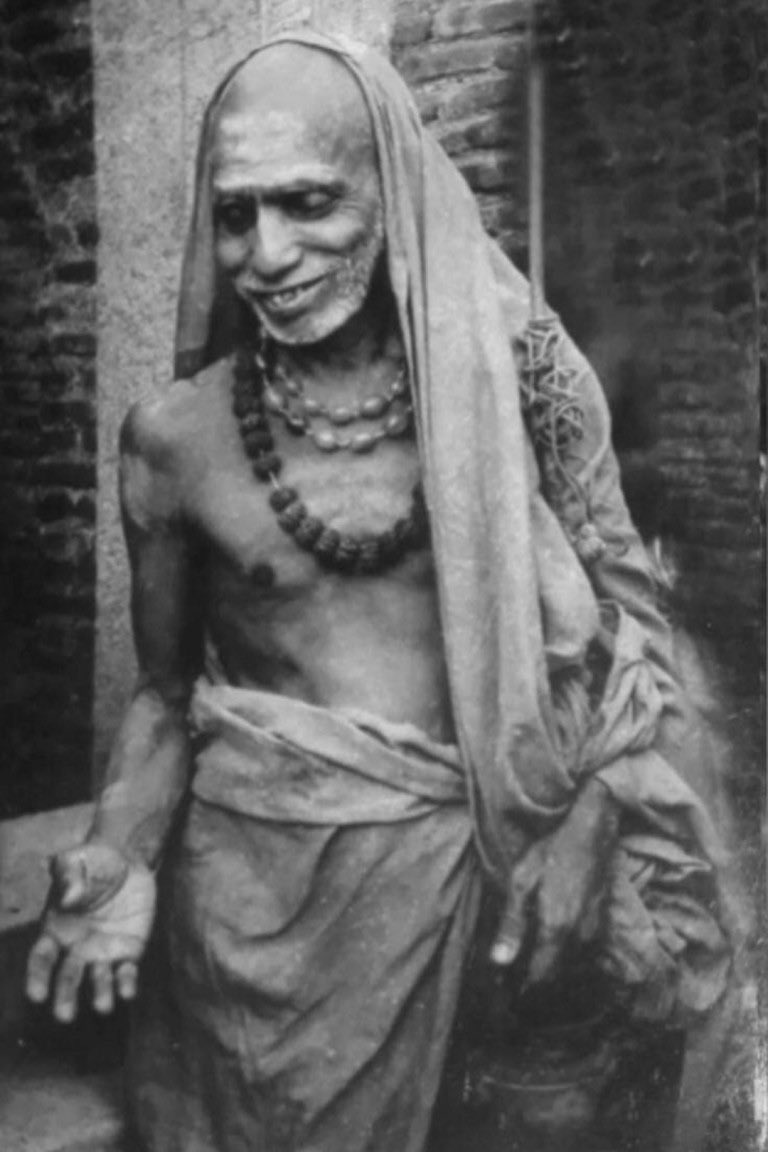
#WhatIsGolu or #Kolu. It simply means divine presence. We know #Navarathiri as the festival of the 3 Devis Durga Lakshmi Saraswathi. Golu is part of this celebration. It is the festive display of dolls and figurines in South India during the Saradha Navaratri (Dussehra Dasara) 



Golu is kept on Mahalaya Amavasai. It is a Hindu festival where women and artistic men display dolls, figurine, which are thematic, narrate a Hindu purana, ithu has a like Ramayana, Mahabharatha, Dasavathara, 6 abides of Subramanya, Siva in Kailash, dances of Nataraja, court life 





everyday scenes and miniature kitchen utensils Ratha Yatra, processions etc along with the divine presence of the Goddesses Saraswati, Parvati and Lakshmi. The steps may also be interpreted as the evolution ladder that we are all traversing in the journey of life. Keeping golu is
predominant in the Tamil, Kannada and Telugu households during Navaratri or The Nine nights. They are also called as #Kolu, #Gombe_Habba, #Bommai_Kolu or #Bommala_Koluvu. On the first day of Navaratri, following Ganapati puja, a welcoming ritual is performed for Saraswati, Durga 

and Lakshmi by a Hindu ritual Kalasa Aavahanam, performed by an elderly male or female of the family at an auspicious time (Each family has a different ritual. Some may or may not follow this). This is then followed by building a rack
of odd-numbered shelves of Kolu (or Padi)
of odd-numbered shelves of Kolu (or Padi)

(usually 3, 5, 7, 9, or 11), set up using wooden planks. (Now umpteen number of innovative options have cropped up in the market which double as a storage unit other than the nine days) After the steps have been covered with fabric it is then adorned with various dolls,
figurines according to their size, with the deities at the top. It is a traditional practice to have wooden figurines of the bride and groom together, called 'Marapacchi Bommai' or 'Pattada Gombe', usually made of sandalwood, teak or rosewood or dried coconut displayed in Kolu. 



In southern India, bride is presented with 'Marapacchi Bommai' during the wedding by her parents as part of wedding trousseau to initiate thep yearly tradition of 'Navaratri Golu' in her new home with her husband. These dolls come as couples dressed in their wedding attire,
depicting husband and wife symbolizing prosperity and fertility and the start of the bride's Golu collection. Display figurines are passed on from one generation to another as heirloom, and are often several generations old. In the old Kingdom of Mysore, 'Pattada Gombe' is also
believed to be a tribute to the kings of the Wodeyar dynasty who ruled of the region for around 600 years. Generally these dolls are typically made by rural artisans from clay and wooden materials then brightly painted. In the evenings, women within the neighborhood invite each 

other to visit their homes to view the Kolu displays, they also exchange gifts and sweets. A Kuthuvilakku lamp is lit, in the middle of a decorated Rangoli, while devotional hymns and shlokas are chanted. After performing the puja, on each day ‘sundal’ or spiced pulses, lentils 

and legumes (a different variety on each day) are offered to the Gods and Goddesses as neividhyam and then to the guests as prasadam.
The first 3 days of the festival are dedicated to Durga, then the next 3 days dedicated to Lakshmi and finally, the last 3 days are dedicated to
The first 3 days of the festival are dedicated to Durga, then the next 3 days dedicated to Lakshmi and finally, the last 3 days are dedicated to
Saraswati. On the 9th day, Saraswati Puja, special pujas are offered to goddess Saraswati. Books and musical instruments are placed in the puja and worshipped as a source of knowledge. The 10th day, Vijayadashami, is the most auspicious day of all. It was the day on which the
demon Mahishasura was finally destroyed by Durga. Mahishasura (Mahisha – buffalo and asura – demon) waged war against the Devas. He had a powerful boon that no man can kill him. When all the devas including Lord Shiva, Lord Brahma, and Lord Vishnu couldn’t defeat Mahishasura,
they decided to create Goddess Durga with all their divine powers combined. Goddess Durga with all her skills battled the asura riding on a lion for nine days and killed him on the day of Vijaya Dasami – the tenth day of Navaratri. Because of this, we worship her by the name 

Mahishasura Mardini also – the one who killed Mahishasura. We celebrate the last day for the victory over the Mahishasura as Vijayadasami. All our festivals are celebrated to rejoice the victory of good over evil. So many auspicious events took place on this day. The Pandavas 

recovered their weapons after their 13 long years of exile in the forest.. It marks a new and prosperous beginning. New ventures started on this day are believed to flourish and bring prosperity. Kids often start tutoring on this day to have a head start in their education.
Later, on the evening of Vijayadashami, one of the doll from the display is symbolically put to sleep, and the Kalasha is moved a bit towards North to mark the end of that year's Navaratri Golu display.[citation needed] Prayers are offered to thank the Lord for the successful 

completion of that year's Navaratri festival and with hope of a successful one the next year. Then the steps are dismantled and the dolls are packed up for the next year. Kolu also has a significant connection with the agricultural and handicrafts professions in India. Besides
the economic aspect of the festival, it is an important occasion for socializing. During this season relatives and friends in south India make it a point to visit each other's homes. This is also a very important occasion that promotes creative expression for women and for the
family to work together on an aesthetic aspect. Major Hindu temples such as the Meenakshi temple and Srirangam temple and several other smaller temples too arrange elaborate golu displays each year for Navaratri.
Sarvam Sri Krishnarpanam 🙏🏻



Sarvam Sri Krishnarpanam 🙏🏻




Some people like @LathaPrasana are quite innovative. This is their house golu 







• • •
Missing some Tweet in this thread? You can try to
force a refresh












